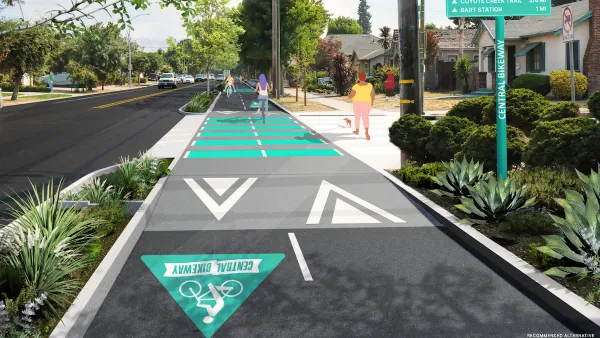This report was prepared for the New Jersey Legislature to document the current state of Personal Rapid Transit (PRT) development and implementation and to explore the potential viability of implementing PRT in New Jersey.
The report summarizes the history of PRT development efforts worldwide, documents lessons learned from past research and development activities, explores the opinions of several PRT industry experts regarding the current state of PRT development, presents the theoretical benefits of PRT when compared to other modes of public transportation, identifies the challenges and risks associated with PRT implementation and presents a series of options for advancing PRT development in New Jersey should decision makers decide to do so.
From the Executive Summary:
"PRT has been the subject of research and development efforts for approximately 40 years. However, there has yet to be a full scale deployment of this technology. A fully operational PRT system is needed to demonstrate the theoretical benefits of PRT and establish commercial readiness and significant research and development activities must still be undertaken. Such a research and demonstration program has been conceptually estimated to require $50-100 million over a three year period.
It is important to note that PRT is an emerging public transportation technology and has not yet advanced to the stage of commercial deployment or achieved wide-spread public operation. As such, much of the information presented in the report, especially information related to the potential benefits of PRT, is based on conceptual engineering and theoretical research from PRT developers, government researchers, or independent consultants. Wherever appropriate the potential or theoretical nature of particular data and information is made clear and the source of information is noted."
From the Implementation Assessment and Conclusion:
"PRT is an innovative transportation concept designed to combine the comfort and convenience of private automobile travel with the efficiency of public transit. It has the theoretical potential to provide a higher level of personal mobility than comparable transit modes at a potentially reduced capital and operating cost. It also holds the promise of being potentially more energy efficient, less land consumptive and more environmentally responsible while improving the overall service, speed and attractiveness of public transportation. Conceptually, PRT could provide a stand-alone network or be part of the larger multi-modal network of urban transit services.
Unfortunately, as documented in previous sections of this report, PRT has not yet advanced to a state of commercial readiness. Additional development work is needed. When considering what potential role PRT could play in New Jersey's transportation future, decision-makers must first understand the challenges that remain to system development and implementation. The development and implementation of PRT must be a long-term strategic initiative. Advancement of PRT will require not only additional technology development but also the development of a new and different business model to support the new transit technology."
Thanks to Jerry Schneider
FULL STORY: Viability of Personal Rapid Transit In New Jersey (PDF, 1.4 MB, 141 pages)

Planetizen Federal Action Tracker
A weekly monitor of how Trump’s orders and actions are impacting planners and planning in America.

Silicon Valley ‘Bike Superhighway’ Awarded $14M State Grant
A Caltrans grant brings the 10-mile Central Bikeway project connecting Santa Clara and East San Jose closer to fruition.

Amtrak Cutting Jobs, Funding to High-Speed Rail
The agency plans to cut 10 percent of its workforce and has confirmed it will not fund new high-speed rail projects.

Oregon Approves Ambitious Framework for ’Microgrids’
Local energy “islands” within the larger power system ensure key facilities can remain online during emergencies and power outages.

A Historic Investment in LA County’s Parks and Open Spaces
Los Angeles County has launched its largest-ever competitive grant program, investing $58 million to expand park access, enhance climate resilience, and support community-driven projects in the areas that need them most.

San Diego Wins $14M for Affordable Housing
The funding comes via the state’s Regional Early Action Planning program and will help create close to 1,000 new housing units.
Urban Design for Planners 1: Software Tools
This six-course series explores essential urban design concepts using open source software and equips planners with the tools they need to participate fully in the urban design process.
Planning for Universal Design
Learn the tools for implementing Universal Design in planning regulations.
Caltrans
City of Fort Worth
New Jersey Institute of Technology
Mpact (founded as Rail~Volution)
City of Camden Redevelopment Agency
City of Portland
City of Laramie


























